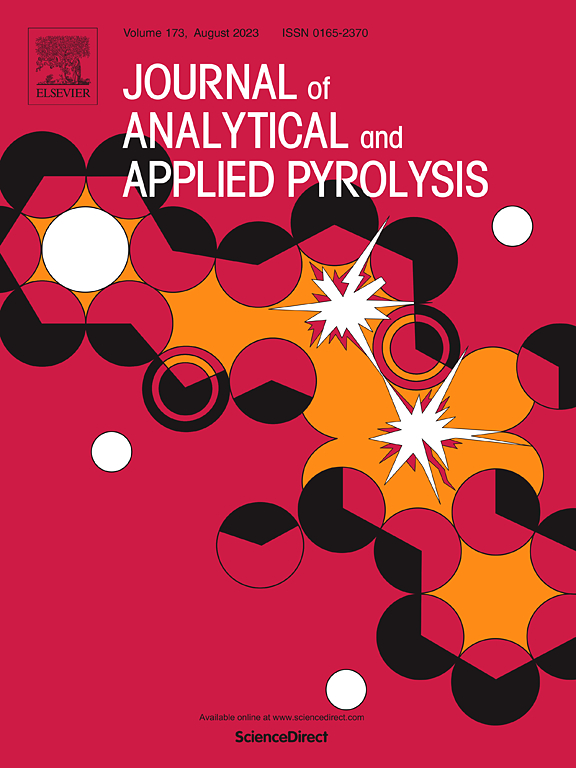Towards enhanced understanding of the synergistic effects between potassium and calcium in biomass catalyzed pyrolysis
IF 5.8
2区 化学
Q1 CHEMISTRY, ANALYTICAL
引用次数: 0
Abstract
In this study, the influences of different parameters on the products of K-Ca synergistically catalyzed biomass pyrolysis and the possible chemical reactions during the process were investigated. Results indicated that, according to the standard Gibbs energy calculations, Ca(OH)2 was more likely to react with carboxyl groups (precursors of CO2) in biomass than KOH at low temperature (< 600 °C), effectively preventing the generation of CO2. Increasing the amount of Ca(OH)2 significantly enhanced this interaction, resulting in gradually decrease of CO2 and CO, and remarkably promoted the generation of H2. With a considerable decrease in the O-containing species, the hydrocarbons and phenols (phenol accounting for 49 %) became the main species in organic liquid products. For solid products, KOH can react and remove most of the oxygen-containing functional groups, while Ca(OH)2 can fixed O-C![]() O groups, resulting in a large amount of O-C
O groups, resulting in a large amount of O-C![]() O groups remaining. Additionally, bimetallic carbonate K2Ca(CO3)2 was formed at Ca(OH)2/KOH/soybean straw ratios below 0.25:1:2, whereas K2Ca2(CO3)3 was generated at higher ratios exceeding 0.25:1:2. At higher temperatures (> 600 °C), the O-C
O groups remaining. Additionally, bimetallic carbonate K2Ca(CO3)2 was formed at Ca(OH)2/KOH/soybean straw ratios below 0.25:1:2, whereas K2Ca2(CO3)3 was generated at higher ratios exceeding 0.25:1:2. At higher temperatures (> 600 °C), the O-C![]() O groups transformed into more stable C
O groups transformed into more stable C![]() O groups, and K2Ca2(CO3)3 decomposed into K2Ca(CO3)2, which increased the content of CO via hydrogenation. As analyzed above, the mechanism of K-Ca synergistically catalyzed biomass pyrolysis was elucidated.
O groups, and K2Ca2(CO3)3 decomposed into K2Ca(CO3)2, which increased the content of CO via hydrogenation. As analyzed above, the mechanism of K-Ca synergistically catalyzed biomass pyrolysis was elucidated.
进一步了解钾和钙在生物质催化热解过程中的协同效应
本研究调查了不同参数对 K-Ca 协同催化生物质热解产物的影响以及过程中可能发生的化学反应。结果表明,根据标准吉布斯能计算,在低温(< 600 °C)下,Ca(OH)2 比 KOH 更容易与生物质中的羧基(CO2 的前体)发生反应,从而有效地阻止了 CO2 的生成。增加 Ca(OH)2 的用量可显著增强这种相互作用,从而使 CO2 和 CO 逐渐减少,并显著促进 H2 的生成。随着含 O 物种的大量减少,烃类和酚类(苯酚占 49%)成为有机液体产物的主要物 种。对于固体产物,KOH 可以反应并去除大部分含氧官能团,而 Ca(OH)2 则可以固定 O-CO 基团,从而使大量 O-CO 基团得以保留。此外,当 Ca(OH)2/KOH/大豆秸秆的比例低于 0.25:1:2 时,会生成双金属碳酸盐 K2Ca(CO3)2,而当比例超过 0.25:1:2 时,则会生成 K2Ca2(CO3)3。在较高温度(> 600 °C)下,O-CO 基团转化为更稳定的 CO 基团,K2Ca2(CO3)3 分解为 K2Ca(CO3)2,通过氢化增加了 CO 的含量。通过上述分析,阐明了 K-Ca 协同催化生物质热解的机理。
本文章由计算机程序翻译,如有差异,请以英文原文为准。
求助全文
约1分钟内获得全文
求助全文
来源期刊
CiteScore
9.10
自引率
11.70%
发文量
340
审稿时长
44 days
期刊介绍:
The Journal of Analytical and Applied Pyrolysis (JAAP) is devoted to the publication of papers dealing with innovative applications of pyrolysis processes, the characterization of products related to pyrolysis reactions, and investigations of reaction mechanism. To be considered by JAAP, a manuscript should present significant progress in these topics. The novelty must be satisfactorily argued in the cover letter. A manuscript with a cover letter to the editor not addressing the novelty is likely to be rejected without review.

 求助内容:
求助内容: 应助结果提醒方式:
应助结果提醒方式:


